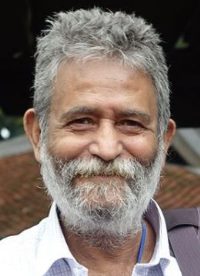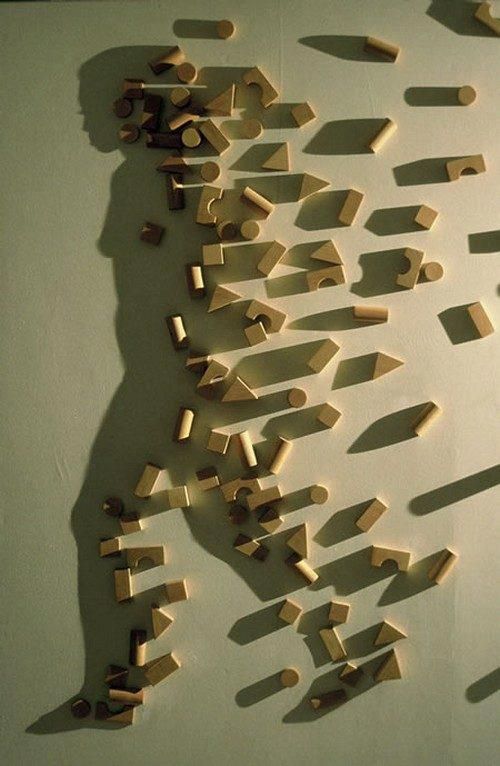Silence (27) - Tĩnh lặng (27). Mai Văn Phấn. Explicated by Dr. Ramesh Chandra Mukhopadhyaya - chú giải. Traduction française Dominique de Miscault – Dịch sang tiếng Pháp. Takya Đỗ dịch sang tiếng Việt
Silence (27) by Mai Văn Phấn
Explicated by Dr. Ramesh Chandra Mukhopadhyaya
Translated into French by Dominique de Miscault
Translated into Vietnamese by Takya Đỗ

Long Bien ou le pont de tous les songes - Dominique de Miscault
Silence
27
My body blends into
darkness
Only my hands remain
alight
My palms turn up
Like two lake surfaces
Two open bowls
Two winter caves
The deep pits of two stars
The mouths of two fish…
One cannot find in the
universe
Pairs
Like two hands
Joining
Because each star, bowl
Fish, cave, lake…
Connects to a separate
darkness.
(Translated from Vietnamese by Nhat-Lang Le & Susan Blanshard)
Explication
Modern
civilization does not pay any attention to rituals. If religious rituals
ever take place in poetry they are mentioned only to be debunked. To show the
hollowness of time honoured rituals is often the function of so called poetry.
That is modernity. Modern poetry looks upon such manners as greeting one with
folded hands as trifle not fit for the stuff of poetry. But Mai
Văn Phấn is different. With him every trifle is instinct with
Buddha mind. So the so called trifles often figure in his poetry to disseminate
light and love. The poem 27 of Silence is an instance.
The first two lines of the poem opens like a
riddle
The body blends into darkness
Only my hands remain alight
It is
said that dust thou art dust returnest, So the body blends into darkness. But
ironically enough. The poet’s hands are alight. How is that? How do the hands
differ from the body? To decode the riddle the reader cannot but proceed
farther in reading the poem.
According
to Indian yoga system there are eleven senses. Five of them are affected by the
images radiated by the world. They are eyes ears noses tongue and skin. Five of
them are sense organs of action such as hands feet mouth rectum and genitals.
Mind is the eleventh sense organ.
The poet
observes in a vision that while his body that includes all the five sense
organs such as nose ears and the like and all the four sense organs of action
such as feet mouth etc vanish into darkness because of impermanence of all
things under the Sun only the two hands in a particular hand gesture remain
illuminated in the encircling gloom. Does it not mean that despite the fact
that while our body vanishes our actions survive? Because hands are the sense
organ of action. Look at any image of Lord Buddha. In some images the
hands touch the earth. In some other images both the hands are in the lap with
the back of the right hand resting on the palm of the left hand. The fingers of
both the palms are stretched. In another set of Buddha images the right hand is
generally raised to shoulder height with arm bent. In other images the hands
are raised to the level of the chest. The palm of the right hand faces outward.
In another gesture the lip of the thumb kisses the lip of the index
finger. While the right hand is raised upto the shoulder the left hand is at
the hip level on the lap and looks upward. In other images both hands are
raised on the chest. The palms and fingers of both the hands join against each
other vertically. This hand gesture is not there in Buddha statues. But it is
found among the bodhisattvas whose only prayer is to liberate every particle of
the existence. And in countries like Thailand Vietnam and in India people greet
each other with clasped palms. Greeting someone with clasped palms means to
greet another person with love compassion and respect. We must respect
everything in the existence because everything in the existence is the
epiphenomenon of the Buddha mind. And clasped palms is a mudra or hand
gesture that helps us to cultivate respect and compassion for everyone and every
thing. The poet very clearly describes how this hand gesture could be forged.
The poets
palms turn up and join with one another.
The poet looks at the capability of man to clasp
the palms as a special privilege pf man When we turn up a palm, there is the
hollow in it. The same hollow is in everything ranging from the stars in the
firmament to the fishes in the water. But alas! Alas! they cannot make up their
hollowness because their limbs are limited or insufficient. One cannot
find in universe pairs like two hands joining. What does the two hands
joining mean? Well it might mean joining the opposites, positive and negative.
The truth is neither the positive nor the negative, neither the not positive
nor the not negative neither the not not positive nor the not not negative.
While other things in the existence are connected to separate darkness, be it
either positive or negative man can alone transcend the logo centrism by
joining the two hands and by cultivating love and respect. Love and
respect for each other can do away with the hollowness lurking in the heart of
an individual. Each one of us is alienated like an island. Let us join our own
hands and cultivate love and respect for others. Let us shake hands and unite
with others. There will be the perfect harmony between yang and yin. The
hollowness and sufferings of man will disappear in the light of Buddha mind and
consciousness perpetual. That is why while the body vanishes into darkness the
hand that are the tools for getting at the Buddha mind are alight.
Explication par Dr. Ramesh Chandra Mukhopadhyaya
Traduction française Dominique de Miscault

Long Bien ou le pont de tous les songes - Dominique de Miscault
Silence
27
Mon corps est
obscur
mes mains
lumineuses
Mes paumes
deux surfaces
lacustres
deux bols
ouverts
deux grottes
en hiver
espace infini
entre deux étoiles
bouches
ouvertes de deux poissons ...
On ne peut pas
trouver
deux univers
tels deux
mains jointes
Chaque étoile,
planète
poisson,
grotte, lac ...
sont aussi
obscurités.
Explication
La civilisation
moderne ne fait plus attention aux rituels. Si les rituels religieux sont
évoqués en poésie, ils n’y sont mentionnés que pour être déconsidérés. Exposer
le manque de rituels honorés par le temps est souvent la fonction d’une
soi-disant poésie. C'est la modernité. La poésie moderne regarde les manières
telles que saluer quelqu’un avec les mains jointes, ce comme inadapté à la
poésie. Mai Văn Phấn est différent. Avec lui, chaque geste vient de Bouddha.
Ainsi, ce qui est appelé bagatelles figurent souvent dans sa poésie pour
diffuser la lumière et l'amour. Le poème 27 de Silence en est un exemple :
Mon corps dans l'obscurité
Seules mes mains sont lumineuses
Il est dit : Souviens-toi que tu es poussière et que tu
retourneras en poussière.
Le corps est donc
obscurité. Mais paradoxalement, les mains du poète sont éclairées. Comment
est-ce possible ? En quoi ses mains seraient-elles dissociées de son corps ?
Pour comprendre, le lecteur doit continuer à lire le poème.
Selon le yoga indien,
il y a onze sens. Cinq d'entre eux irradient le monde : Ce sont les yeux, les
oreilles, la langue, la peau et l’odorat. Les cinq autres sont les organes de
l'action tels que les mains, les pieds, la bouche, le rectum et les organes
génitaux. L'esprit est le onzième organe des sens.
Le poète observe
qu’alors que son corps avec ses cinq sens, les oreilles, le nez et les autres
et tous les cinq organes de l'action tels que la bouche des pieds etc.
disparaissent dans l'obscurité à cause de l'impermanence sous le Soleil. Seules
ses deux mains dans un geste spécifique restent lumineuses dans l'obscurité.
Cela ne signifierait-t-il pas que malgré la disparition de notre corps, nos
actions survivent ? Les mains sont du domaine de l’action. Regardez Bouddha :
Ses mains peuvent toucher la terre ou ses deux mains se tiennent, l'arrière de
la main droite reposant sur la paume de la main gauche et les doigts étirés. Dans
une autre série de postures du Bouddha : La main droite est levée à la hauteur
de l'épaule avec le bras plié ou encore, les mains sont relevées au niveau de
la poitrine, la paume de la main droite est tournée vers l'extérieur. Dans un
autre geste, le bout du pouce touche le bout de l'index. Alors que la main
droite est relevée sur l'épaule, la main gauche est au niveau de la hanche sur
le genou et regarde vers le haut. Dans d'autres images, les deux mains sont
relevées sur la poitrine. Les paumes et les doigts des deux mains se rejoignent
verticalement. On ne trouve pas de mains jointes dans les statues de Bouddha.
Par contre, on les trouve chez certains bodhisattvas dont la seule raison
d’être est de libérer toutes les particules de vie. En Thaïlande, au Vietnam et
en Inde, on se salue les mains jointes. Saluer quelqu'un avec les mains jointes
signifie amour, compassion et respect. Nous devons tout respecter dans
l'existence parce que tout dans l'existence est l'épiphénomène de l'esprit du
Bouddha. Les mains jointes sont un geste qui nous aide à cultiver le respect,
la compassion pour chacun et toutes choses. Le poète décrit très clairement
comment ce geste de la main doit être pratiqué. Les paumes des poètes
apparaissent et se rejoignent.
Le poète mesure la
capacité de l'homme à serrer ses paumes comme un privilège. Quand nous
présentons notre paume, il y a un creux. Ce même creux se retrouve dans les
étoiles du firmament ou chez les poissons dans l'eau. Mais hélas ! Hélas ! On
ne peut pas compenser nos faiblesses car nous sommes limités. Il n’y a pas de
double univers tel deux mains qui se joignent. Qu'est-ce que ces deux mains qui
se joignent ? Cela pourrait signifier que les contraires se rejoignent,
positifs et négatifs. La vérité n'est ni positive ni négative, ni pas positive
ou pas négative ni le non positif ni le négatif.
Bien que des choses
de l'existence soient liées à l’obscurité, que ce soit positif ou négatif,
l'homme peut seul transcender son égocentrisme en joignant les deux mains et en
cultivant l'amour et le respect. L'amour et le respect des uns envers les
autres peuvent éliminer le vide qui se cache dans notre cœur. Chacun de nous
est enfermé en lui-même comme sur une île. Joignons nos mains et cultivons
l'amour et le respect pour les autres. Nous serrons la main qui s’unit aux
autres. Ainsi il y aura l'harmonie parfaite entre le yang et le yin. Le vide et
les souffrances de l'homme disparaîtront à la lumière de l'esprit du Bouddha et
de la conscience infinie. C'est pourquoi, alors que le corps disparaît dans les
ténèbres, la main qui est l'outil pour parvenir à l'esprit de Bouddha est
lumineuse.
Tĩnh lặng (27) của Mai Văn Phấn
Ramesh Chandra Mukhopadhyaya chú giải
Takya Đỗ dịch sang tiếng Việt
27
Cơ thể tôi lẫn vào bóng tối
Chỉ sáng đôi bàn tay
Lòng tay lật lên
Tựa hai mặt hồ
Hai chiếc bát để ngửa
Hai cửa hang mùa đông
Hố trũng hai ngôi sao
Miệng hai con cá...
Không thể tìm trong vũ trụ
Những cặp song trùng
Tựa đôi bàn tay
Khép lại
Bởi mỗi ngôi sao, chiếc bát
Con cá, hang sâu, hồ nước...
Nối với từng bóng tối khác nhau.
Chú giải:
Nền văn minh hiện
đại chẳng quan tâm gì đến lễ nghi. Nếu các nghi lễ tôn giáo có diễn ra trong
thi ca thì chúng cũng chỉ được đề cập đến chỉ để bị lật tẩy. Phơi bày sự giả
dối của những nghi lễ đã thành truyền thống thường là trách nhiệm của cái được
gọi là thi ca. Đó là tính hiện đại. Thi ca hiện đại coi những kiểu cách như chắp
tay chào ai đó là nhỏ nhặt tầm thường không phù hợp với tinh thần thi ca. Nhưng
Mai Văn Phấn thì khác. Với ông mỗi thứ tầm thường nhỏ nhặt đều là bản năng chứa
đựng Phật tâm, thế nên những thứ mà người ta gọi là nhỏ nhặt ấy thường hiện
diện trong thơ của ông để lan tỏa ánh sáng và tình yêu. Bài thơ Tĩnh lặng số 27
là một ví dụ.
Hai dòng đầu của
bài thơ mở đầu như một câu đố:
Cơ thể tôi lẫn vào bóng tối
Chỉ sáng đôi bàn tay
Có câu rằng là cát bụi ngươi lại trở về với cát bụi,
nên cơ thể ấy lẫn vào bóng tối. Nhưng trớ trêu thay, đôi bàn tay nhà thơ vẫn
sáng. Sao lại thế được? Làm sao mà đôi bàn tay lại không giống với toàn bộ cơ
thể? Để giải câu đố này thì người đọc chỉ còn cách đọc tiếp bài thơ.
Theo hệ thống phân loại của yoga Ấn độ, có 11
giác quan cả thảy. Năm trong số này bị tác động bởi những hình ảnh từ thế giới
chiếu ra, đó là mắt, tai, mũi, lưỡi và da. Năm giác quan khác là các cơ quan
cảm giác hành động như tay, chân, miệng, trực tràng và cơ quan sinh dục. Tâm
trí là cơ quan cảm giác thứ mười một.
Trong một ảo cảnh, nhà thơ thấy rằng trong
lúc cơ thể ông, gồm toàn bộ năm giác quan như mũi, tai và những giác quan cùng
loại và tất cả bốn giác quan hành động như miệng, chân vân vân đều tan biến vào
bóng tối bởi tính tạm thời ngắn ngủi của mọi vật dưới ánh mặt trời, chỉ riêng
đôi bàn tay trong một cử chỉ đặc biệt là vẫn được chiếu sáng trong cái bóng tối
vây phủ đó. Chẳng phải điều đó có nghĩa là bất chấp cái thực tại khi cơ thể ta
tan biến vào hư vô thì hành động của ta vẫn tiếp tục tồn tại hay sao? Bởi vì
đôi bàn tay là cơ quan cảm giác hành động. Hãy xem bất kỳ bức tranh nào vẽ Đức
Phật. Trong một số bức đôi bàn tay chạm xuống đất. Trong một số bức tranh khác cả
hai bàn tay đặt trên lòng với mu bàn tay phải đặt trên lòng bàn tay trái, các ngón tay trên cả hai bàn tay đều duỗi ra.
Trong loạt những bức tranh khác nữa bàn tay phải thường giơ lên đến ngang vai
và khuỷu tay gập lại. Lại có những bức mà đôi tay giơ lên ngang ngực, lòng bàn
tay phải hướng ra ngoài. Trong một cử chỉ khác rìa ngón tay cái chạm hờ vào
cạnh ngón tay phải, trong khi bàn tay phải giơ lên đến ngang vai thì bàn tay
trái nằm trên lòng ở vị trí ngang hông và lòng bàn tay hướng lên trên. Trong
những bức khác cả hai tay giơ lên ngang ngực, đôi bàn tay chắp lại thẳng đứng.
Cử chỉ bàn tay kiểu này không thấy có ở các pho tượng Phật. Mà có thể thấy ở
các vị Bồ tát, những vị này chỉ tâm niệm một điều là giải phóng mọi loài trong hiện
tồn.
Và ở những nước như Thái Lan, Việt Nam và Ấn
độ, người ta thường chào hỏi nhau bằng cách chắp hai tay lại. Chào hỏi ai bằng
hai tay chắp lại là tỏ ý chào hỏi người đó với lòng yêu mến, nhiệt tình và kính
trọng. Chúng ta cần phải tôn trọng mọi vật trong hiện tồn bởi mọi vật trong hiện
tồn đều là hiện tượng phụ
của Phật tâm. Và hai bàn tay chắp lại là mudra
hay cử chỉ bàn tay giúp chúng ta nuôi dưỡng lòng kính trọng và trắc ẩn với mọi
người và mọi vật. Nhà thơ miêu tả rất rõ có thể bắt chước cử chỉ bàn tay này ra
sao.
Hai lòng bàn tay của nhà thơ lật lên và khép
vào nhau.
Nhà thơ xem cái khả năng chắp tay như một đặc
quyền của con người. Khi ta lật ngửa lòng bàn tay, sẽ có hố trũng trong đó. Cái
hố trũng như thế cũng có ở mọi vật từ những ngôi sao trên trời đến những con cá
dưới nước. Nhưng than ôi! Than ôi! chúng không thể tự lấp đầy những hố trũng
này bởi các chi của chúng bị hạn chế hoặc thiếu hụt. Người ta không thể tìm
thấy trong vũ trụ những cặp song trùng tựa đôi bàn tay khép lại. Thế hai bàn
tay khép lại có ý nghĩa gì? Ờ, có thể nó mang ý nghĩa là kết hợp những cái đối
lập, như tích cực và tiêu cực. Chân lý chẳng phải tích cực cũng không phải tiêu
cực, chẳng phải là không tích cực cũng chẳng phải không tiêu cực, sắc sắc không
không. Khi những vật khác trong hiện tồn được kết nối với từng bóng tối khác
nhau, thì dù là người tích cực hay người tiêu cực đều có thể một mình vượt lên khỏi
ngôn từ trung tâm luận
bằng cách khép hai bàn tay và bằng cách nuôi dưỡng lòng yêu mến và kính trọng.
Lòng yêu mến và kính trọng lẫn nhau có thể giúp người ta thoát khỏi cái hố
trũng ẩn trong trái tim mỗi người. Mỗi người chúng ta đang bị chia cách như một
hòn đảo. Chúng ta hãy chắp tay lại và nuôi dưỡng lòng yêu mến và kính trọng đối
với những người khác. Chúng ta hãy bắt tay nhau và kết liên với những người
khác. Giữa dương và âm sẽ có sự hài hòa tuyệt đối. Cái hố trũng và sự thống khổ
của con người sẽ biến mất dưới ánh sáng Phật tâm và ý thức bất diệt. Đó là lý
do tại sao trong khi cơ thể tan biến vào bóng tối thì đôi tay, cái phương tiện
để đạt đến Phật tâm ấy, lại bừng sáng.
______________
[1] Nguyên văn ‘dust thou art dust returnest’, là câu
trích từ bài A Psalm Of Life (tạm dịch: Bài
Thánh vịnh cuộc đời) của nhà thơ Mỹ Henry Wadsworth Longfellow (1807-1882);
nguyên câu thơ này là lời Chúa phán bảo Adam khi Ngài đuổi Adam và Eve ra khỏi
Địa đàng (‘dust thou art, and unto dust
shalt thou return’ - Sáng thế ký 3:13). (ND)
[2] Nguyên văn ‘epiphenomenon’, một số từ điển tiếng Anh
cho nghĩa triết học của từ này là “Một
hiệu ứng thứ yếu hoặc một kết quả phụ của một hiện tượng khác”.
(http://www.thefreedictionary.com/Epiphenomenon;
https://en.oxforddictionaries.com/definition/epiphenomenon...
)
Wikipedia giải thich rõ
hơn: “Epiphenomenon là một hiện tượng thứ yếu xảy ra theo hoặc
song song với hiện tượng chủ yếu”
(https://en.wikipedia.org/wiki/Epiphenomenon).
(ND)
[3] Nguyên văn ‘logocentrism’, một thuật ngữ do triết
gia Đức Ludwig Klages đặt ra khoảng những năm 1920; nó đề cập đến truyền thống
khoa học và triết học phương Tây coi ngôn từ và ngôn ngữ như sự biểu hiện cơ
bản của một thực tại bên ngoài.
(https://en.wikipedia.org/wiki/Logocentrism).
Một số tài liệu tiếng Việt dịch từ này là ‘ngôn tâm luận’ hoặc ‘lý tâm luận’..., tác giả Nhật Chiêu
trong bài ‘Thiền và Hậu hiện đại’ của
mình dùng ‘ngôn từ trung tâm luận’ là
cách diễn dịch gần nhất với chủ đề đang được đề cập ở đây. (ND)

Ts. Ramesh Chandra Mukhopadhyaya
Dr. Ramesh Chandra Mukhopadhyaya
Address: 6/ 1 Amrita Lal Nath lane P.0. Belur Math Dist Howrah West Bengal India Pin code711202. Date of Birth 11 02 1947. Education M.A [ triple] M Phil Ph D Sutrapitaka tirtha plus degree in homeopathy. He remains a retired teacher of B.B. College, Asansol, India. He has published books in different academic fields including religion, sociology, literature, economics, politics and so on. Most of his books have been written in vernacular i.e. Bengali. Was awarded gold medal by the University of Calcutta for studies in modern Bengali drama.
TS. Ramesh Chandra Mukhopadhyaya
Địa chỉ: 6/ 1 đường Amrita Lal Nath hòm thư Belur Math Dist Howrah Tây Bengal Ấn Độ mã số 711202. Ngày sinh: 11 02 1947. Thạc sĩ văn chương, thạc sĩ triết học, tiến sĩ triết học [bộ ba] cùng với Bằng y học về phép chữa vi lượng đồng cân. Ông còn là một giảng viên đã nghỉ hưu của Trường đại học B.B, Asansol, Ấn Độ. Ông đã có những cuốn sách được xuất bản về nhiều lĩnh vực học thuật bao gồm tôn giáo, xã hội học, văn học, kinh tế, chính trị v.v. Hầu hết sách của ông đã được viết bằng tiếng bản địa là tiếng Bengal. Ông đã được tặng thưởng huy chương vàng của Trường đại học Calcutta về các nghiên cứu nghệ thuật sân khấu Bengal hiện đại.

Nhà thơ - Nghệ sỹ Dominique de Miscault
Poétesse - Artiste Dominique de Miscault
Artiste Plasticienne. Actualités. De plages en pages qui se tournent. C’était hier, de 1967 à 1980, mais aussi avant hier. puis de 1981 à 1992. Et encore de 1992 à 2012 bien au delà des frontières. Aujourd’hui, la plage est blanche sous le bleu du soleil. Ecrire en images, cacher les mots porteurs de souffrance ; on ne raconte pas les pas d’une vie qui commence en 1947. C’est en 1969 que j’ai été invitée à exposer pour la première fois. Depuis j’ai eu l’occasion de « vagabonder » seule ou en groupe en France et dans le monde sûrement près de 300 fois. Les matériaux légers sont mes supports, ceux du voyage et de l’oubli.
www.dominiquedemiscault.fr
www.dominiquedemiscault.com
www.aleksander-lobanov.com
Nhà thơ - Nghệ sỹ Dominique de Miscault
Nghệ sĩ nghệ thuật thị giác đương đại. Từ bãi biển đến trang giấy. Là ngày hôm qua, từ 1967 đến 1980, và trước đó, rồi từ 1981 đến 1992. Và nữa từ 1992 đến 2012 trên tất cả các biên giới. Ngày hôm nay là bãi biển trắng dưới bầu trời xanh. Viết bằng hình ảnh, giấu từ ngữ mang nỗi đau, người ta không kể lại những bước đi trong cuộc đời tính từ năm 1947. Vào năm 1969, lần đầu tiên tôi được mời triển lãm tác phẩm. Kể từ đó, tôi có cơ hội một mình "lang bạt" hoặc theo nhóm ở nước Pháp và khắp nơi trên thế giới, chắc chắn gần 300 lần. Những chất liệu nhẹ là nguồn hỗ trợ tôi, những chất liệu của hành trình và quên lãng.
www.dominiquedemiscault.fr
www.dominiquedemiscault.com
www.aleksander-lobanov.com
Tĩnh lặng - Silence (1)
Tĩnh lặng - Silence (2)
Tĩnh lặng - Silence (3)
Tĩnh lặng - Silence (4)
Tĩnh lặng - Silence (5)
Tĩnh lặng - Silence (6)
Tĩnh lặng - Silence (7)
Tĩnh lặng - Silence (8)
Tĩnh lặng - Silence (9)
Tĩnh lặng - Silence (10)
Tĩnh lặng - Silence (11)
Tĩnh lặng - Silence (12)
Tĩnh lặng - Silence (13)
Tĩnh lặng - Silence (14)
Tĩnh lặng - Silence (15)
Tĩnh lặng - Silence (16)
Tĩnh lặng - Silence (17)
Tĩnh lặng - Silence (18)
Tĩnh lặng - Silence (19)
Tĩnh lặng - Silence (20)
Tĩnh lặng - Silence (21)
Tĩnh lặng - Silence (22)
Tĩnh lặng - Silence (23)
Tĩnh lặng - Silence (24)
Tĩnh lặng - Silence (25)
Tĩnh lặng - Silence (26)

Tác phẩm của HS. Randy Cano, Hoa Kỳ